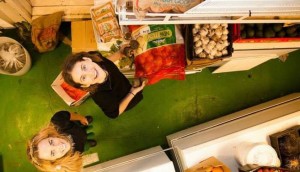 Laura Daikin joined the Sea Shepherd Conservation Society in 2005 at the age of 21. She began her career in the kitchen as a dishwasher, but after just a month, Laura was thrown into the deep end and promoted to chief cook (affectionately called galley slave) on the Steve Irwin. She fell in love with vegan cooking and rose to the challenge of preparing three meals a day for 50 crew members. Her new book Cookin’ Up a Storm: Sea Stories and Vegan Recipes from Sea Shepherd’s Anti-Whaling Campaigns features 80 of the crew’s favorite vegan recipes that have been modified for the home kitchen. When she’s not sailing the high seas, Laura lives in Australia and is the head chef at a non-for-profit, pay-as-you-feel vegan restaurant in Newtown, New South Wales.
Laura Daikin joined the Sea Shepherd Conservation Society in 2005 at the age of 21. She began her career in the kitchen as a dishwasher, but after just a month, Laura was thrown into the deep end and promoted to chief cook (affectionately called galley slave) on the Steve Irwin. She fell in love with vegan cooking and rose to the challenge of preparing three meals a day for 50 crew members. Her new book Cookin’ Up a Storm: Sea Stories and Vegan Recipes from Sea Shepherd’s Anti-Whaling Campaigns features 80 of the crew’s favorite vegan recipes that have been modified for the home kitchen. When she’s not sailing the high seas, Laura lives in Australia and is the head chef at a non-for-profit, pay-as-you-feel vegan restaurant in Newtown, New South Wales.
Chic Vegan: What motivated you to become vegan? Was it an overnight switch or more gradual shift?
Laura Dakin: It was actually a fabric inquiry that set me on the path towards a vegan life-style. I was working for a high-end clothing company in Bermuda, and after the shock of coming across a baby camel skin coat, I became very interested in where clothing materials originated. It set me on a course of discovery and I quickly, almost overnight, decided to distance myself from industry that openly exploited animals.
Luckily for me, shortly after I became vegan, the Sea Shepherd vessel Farley Mowat stopped in Bermuda before continuing north, to fight the Canadian Seal Slaughter, and I was invited to join the campaign.
My vegan life-style has developed and evolved over the years. For me ‘living vegan’ is a constant education.
CV: When people learn that you are vegan, what is the #1 question they ask and what is your response?
LD: I think the most common questions people ask vegans are regarding nutrition. The most repeated question I get asked is a close tie between “Where do you get your protein from?” and “Where do you find iron?”.
Typical beliefs that certain nutrients can only be obtained from animal sources are propagated by the multi-billion dollar meat and dairy industry. If folks took a closer look at nutrition, they would find that a fully balanced diet can come from plant based foods.
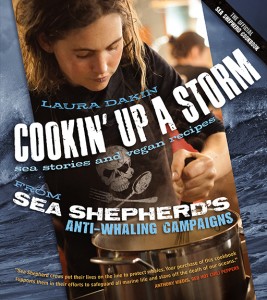 CV: Tell me a little bit about your new book Cookin’ Up a Storm and what inspired you to write it.
CV: Tell me a little bit about your new book Cookin’ Up a Storm and what inspired you to write it.
LD: Upon returning to port, many crew ask me for recipes they’d enjoyed during campaign. I was forever writing out recipes for folks, and decided putting it all together in a book was the next step. When I finally set my mind to writing the book, I completely underestimated how time consuming the project would be! It was only once I really started tracking meals and recording recipes that I appreciated how much work actually goes into a cookbook.
I wanted it to be a touch more then just a recipe book. Media is usually very focused on the action/political side of Sea Shepherd’s anti-whaling campaigns, and I thought people might find the domestic, every-day side of being at sea interesting. So I really hope that throughout the book I have managed to provide a small insight into life on the open ocean.
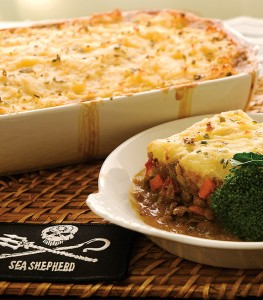 CV: Do you have any favorite recipes in the book?
CV: Do you have any favorite recipes in the book?
LD: I would have to say the Sea Shepherd’s Pie drowned in Punk Rock Gravy is my favourite. I love making it, and I love eating it. It’s pretty easy to prepare, and hopefully there are left-overs for lunch the next day. It’s total comfort food.
CV: What motivated you to work with the Sea Shepherd?
To be honest I didn’t really know Sea Shepherd existed when I randomly met the crew in Bermuda while they were en-route to the seal killing fields, off the East Coast of Canada. I was just 21 years old and had recently gone vegan. I sat on a bench, with my now good friend Captain Peter Hammarstedt, and listened while he explained the organisation to me. I was hooked from that moment. I had finally found ‘my people’ :).
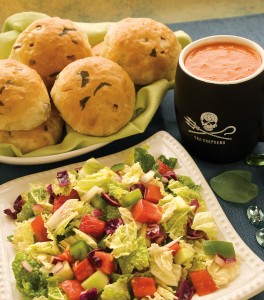 CV: How difficult is it to prepare for a mission at sea? How far in advance do you start planning meals?
CV: How difficult is it to prepare for a mission at sea? How far in advance do you start planning meals?
LD: It is always nerve racking the day the lines are cast and you realise there is no turning back for forgotten ingredients! I like to move onto the ship about 2-3 months prior to departure to make sure I have everything squared away. There is always much cleaning and sorting to do, inventory to take, donations to gather and orders to place. On top of all that the port crew still need 3 hot meals a day.
Meal planning really begins when it’s time to shop – about a week before we cast off. My thoughts run something like this…
‘We will have about 2 pasta based meals per week. So that’s about 25 pasta meals in total. We go through about 5ks of pasta per meal, we have 50kg’s in stock….so I need to buy 75kg of past. Etc!’
If anything I over-order, so we are sure not to run out of stock. Any non-perishable foods that are not consumed during campaign, simply get used up over the course of the year.
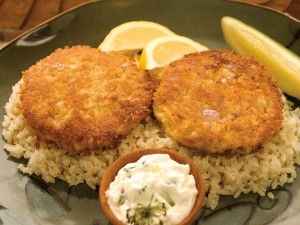 CV: What is a typical day for you like when you’re at sea on the Steve Irwin?
CV: What is a typical day for you like when you’re at sea on the Steve Irwin?
LD: How the day pans out is very weather dependant, but generally begins at about 0630 with breakfast preparation. Breakfast is a solo mission, and the three cooks rotate the responsibility. The meal generally includes toast, fruit (fresh or dried depending on how long we have been at sea), and cereals, as well as a hot dish such as porridge or pancakes and is served from 0730 to 0830.
There is often an hour off after breakfast for us galley crew. During this time we meet, drink coffee and plan the rest of the days meals.
Lunch preparation begins at 0930 and the meal is served at 1200. Soups and stews are mid-day favourites. Lunch is also a great time to get creative with any of the previous nights leftovers which often influence the meal choice.
The galley crew then gets a couple of hours off before dinner preparation unless we are planning a special feast, which we do for fun a couple of times a week and on occasions such as christmas and birthdays. Also each day, one of the three of us galley crew will be in charge of providing afternoon tea, and will make a cake or cookies for the 1500 tea break. Dinner preparations begin soon after tea time and the evening meal is served at 1800. Dinner favourites include curries, jacket potatoes, spaghetti lentil bolognese, falafel and stir fries. Oh and pizza night is always a big hit!
After the evening meal is served and there’s a decent stash of night-time snacks on hand for the late shifts, the galley is is cleaned a secured for the night and we cooks often spend what’s left of the day chatting in the mess, playing cards or curling up in an armchair with a good book.
CV: What is your favourite vegan indulgence?
LD: Chocolate coconut ice-cream. It totally ricks my world!
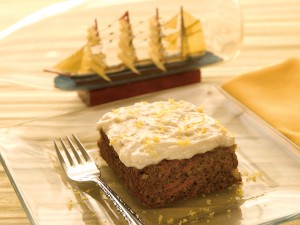 CV: What vegan product could you not live without?
CV: What vegan product could you not live without?
LD: Often at sea we must learn to live without our most treasured vegan products, but in my ideal kitchen the cupboard is never without nutritional yeast – I know thats no surprise to fellow vegans!
CV: In your wildest dreams what will your life look like in 5 years?
LD: In my wildest dreams life is different. Animals exist only for themselves and natural balance is restored. Basically my life is pretty easy going. I’m just cooking for folks, growing veggies, swimming in oceans teaming with life, and hanging out with loved ones.
Oh and I never go to sea unless it’s to sail down wild rugged coast, only to drop anchor in beautiful calm bays!
Feature image courtesy of Sea Shepherd.
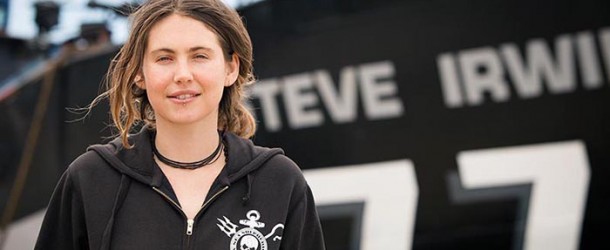
Where can I buy the cook up a storm cook book please.
Julie Clark
Click the link in the post to buy it on Amazon.